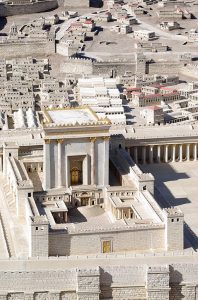Jesus often uses phrases or even single words to allude to teachings in the Old Testament. He could do this because he lived in a biblically knowledgeable Jewish culture. People were familiar with the Old Testament scriptures, because they lived in an oral culture in which people learned the text largely by heart.
Jesus’ culture also had the habit of public discussion about the Bible. Traveling rabbis would teach in each village, and the town’s conversation would revolve around Scripture and the latest teaching. As odd as it sounds to us, many cultures throughout world history have put religion in the center of public culture, so that people are widely literate about religious matters. It has only been in the twentieth century that many societies have become publicly secular, and people ignorant about faith issues.
So Jesus, like others, had a sophisticated teaching style that expected his audience to be familiar enough with the scriptures that they knew the references he was making. By knowing the reference, people would know the entire context and hear more complex ideas behind his words. He wasn’t hiding secret messages — actually, he expected people to catch his allusions. In medieval times, the Jews referred to this technique of hinting as “Remez,” but the practice predated Jesus.
We actually do the same thing today. When a headline says “War in Afghanistan May Be Another Vietnam,” it is assuming that everyone knows the history of the Vietnam War. Without saying anything but the word “Vietnam,” people immediately know the reference and have an emotional reaction to that difficult time in US history.
Or, when we refer to a government scandal as “Travel-gate” or “File-gate” we are subtly alluding to the Watergate scandal. Just by adding that half word, we hint that the issue is a major White House scandal that will cast a shadow over the presidency. Even in the last sentence, you need to know which white house I am talking about! These allusions are a way of quickly referring to common cultural knowledge.
We can find many, many of these in the gospels. Here’s one passage from Mark where Jesus uses this technique:
He entered the temple and began to drive out those who were buying and selling in the temple, and overturned the tables of the money changers and the seats of those who were selling doves; and He would not permit anyone to carry merchandise through the temple. And He began to teach and say to them, “Is it not written, ‘my house shall be called a house of prayer for all the nations‘? But you have made it a robber’s den.” (Mark 11:15 -17)
Jesus is using two quotes from the Old Testament prophets about the Temple. One is “my house will be called a house of prayer for all nations” which comes out of a text from Isaiah 56:
Also the foreigners who join themselves to the LORD,
To minister to Him, and to love the name of the LORD,
To be His servants, every one who keeps from profaning the Sabbath
And holds fast My covenant;
Even those I will bring to My holy mountain
And make them joyful in My house of prayer.
Their burnt offerings and their sacrifices will be acceptable on My altar;
For My house will be called a house of prayer for all the nations. (Is. 56:6-7)
The other comes from Jeremiah 7:
Will you steal, murder, and commit adultery and swear falsely, and offer sacrifices to Baal and walk after other gods that you have not known, then come and stand before Me in this house, which is called by My name, and say, ‘We are delivered!’—that you may do all these abominations? “Has this house, which is called by My name, become a den of robbers in your sight? Behold, I, even I, have seen it,” declares the LORD. “But go now to My place which was in Shiloh, where I made My name dwell at the first, and see what I did to it because of the wickedness of My people Israel. (Jer. 7:9-12)
Both of the passages share a common subject — God’s “house,” the Temple — in fact, in some ancient texts, both passage use the exact phrase “my house.”
Rabbis would look for an exact word match in order to link two texts together. This technique was called gezerah sheva. Another example is with the two texts “You shall love the Lord with all of your heart…”(Deut. 6:5) and “You shall love your neighbor as yourself” (Lev 19:18). When they are quoted together it is because the word “Ve’ahavta” (You shall love) is in common between them. Rabbis would assume that one passage would shed light on the other, or would combine the two to teach a new thing.
 So what is Jesus saying about the Temple in the passage in Mark? If we just read the surface meaning, Jesus says that the Temple is supposed to be a place where people pray, not a place where people do business, and maybe unscrupulously too. The Isaiah passage, however, describes God’s greatest goal for the temple: that it would be a place of worship not just for Jews but for all the nations of the world.
So what is Jesus saying about the Temple in the passage in Mark? If we just read the surface meaning, Jesus says that the Temple is supposed to be a place where people pray, not a place where people do business, and maybe unscrupulously too. The Isaiah passage, however, describes God’s greatest goal for the temple: that it would be a place of worship not just for Jews but for all the nations of the world.
The Jeremiah passage describes the worst possible abuse, where people are being openly wicked, and then fleeing to the temple because they figure God would protect it from destruction. It says that he let the temple be destroyed at Shiloh, and then threatens God would do it again if they didn’t repent.
Some think Jesus was particularly angry that the sellers were crowding the Gentiles out of the court of the Gentiles, the area of the Temple where foreigners could worship the true God.
However, the message may be even stronger than that. It is known from Josephus and other ancient historians that the Jewish temple authorities were deeply corrupt in Jesus’ time. They profited from the sale of sacrificial animals, extorted pay from the other priests, and had people who opposed them killed. Several of Jesus’ sayings were about the destruction of the Temple because of its corruption, and in Mark 14 we read his prediction that the Temple would be destroyed.
Jesus is very likely using Jeremiah 7 to hint that the selling in the Temple is only one symptom of great corruption that would ultimately lead to God’s judgement. “Den of robbers” doesn’t just refer to the sellers, it refers to the wicked temple authorities.
Since we know that we put cultural “hints” in our own conversation, we should expect that Jesus would in his words too. Certainly by learning more about his first century culture we can understand Jesus better.
We should take joy to see that the source of Jesus’ “hints” is something that we already have at our fingertips — the Old Testament. This should challenge all of us to learn the Scriptures he read, if we want to understand Jesus and follow him.
~~~~
 To explore this topic more, see chapter 3, “Stringing Pearls” in Sitting at the Feet of Rabbi Jesus, Zondervan, 2009, p. 36-50.
To explore this topic more, see chapter 3, “Stringing Pearls” in Sitting at the Feet of Rabbi Jesus, Zondervan, 2009, p. 36-50.
A major reference for this article is “Remember Shiloh,” by Joseph Frankovic.
Photos: James Tissot [Public domain], Berthold Werner [Public domain]


